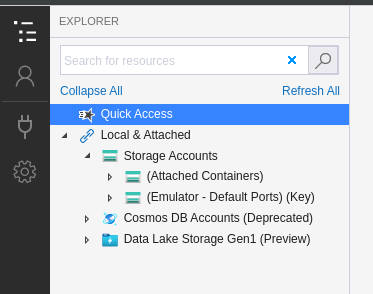

- #Azure storage emulator blob container how to#
- #Azure storage emulator blob container install#
- #Azure storage emulator blob container download#
- #Azure storage emulator blob container free#
vhd/.vhdx files as page blobs (recommended). Acceptable choices are Append, Page, or Block blob. This operation gives you the option to upload a folder or a file.Ĭhoose the files or folder to upload. Most files stored in Blob storage are block blobs. Append blobs are used for logging, such as when you want to write to a file and then keep adding more information. VHD files used to back IaaS VMs are page blobs.

Once the blob container has been successfully created, it is displayed under the Blob Containers folder for the selected storage account.īlob storage supports block blobs, append blobs, and page blobs. When complete, press Enter to create the blob container. See the Create a container section for a list of rules and restrictions on naming blob containers. Select Blob Containers, right-click and select Create Blob Container. To create a container, expand the storage account you created in the proceeding step. This view gives you insight to all of your Azure storage accounts as well as local storage configured through the Azurite storage emulator, Cosmos DB accounts, or Azure Stack environments. Select the Azure subscriptions that you want to work with, and then select Open Explorer.Īfter Storage Explorer finishes connecting, it displays the Explorer tab. Storage Explorer will open a webpage for you to sign in.Īfter you successfully sign in with an Azure account, the account and the Azure subscriptions associated with that account appear under ACCOUNT MANAGEMENT. You can sign in to global Azure, a national cloud or an Azure Stack instance. In the Select Azure Environment panel, select an Azure environment to sign in to. In the Select Resource panel, select Subscription. Several resource options are displayed to which you can connect: On first launch, the Microsoft Azure Storage Explorer - Connect to Azure Storage dialog is shown.
#Azure storage emulator blob container install#
To install Azure Storage Explorer for Windows, Macintosh, or Linux, see Azure Storage Explorer. This quickstart requires that you install Azure Storage Explorer. For help creating a storage account, see Create a storage account. For this quickstart, create a storage account using the Azure portal, Azure PowerShell, or Azure CLI.
#Azure storage emulator blob container free#
If you don't already have a subscription, create a free account before you begin.Īll access to Azure Storage takes place through a storage account. To access Azure Storage, you'll need an Azure subscription.
#Azure storage emulator blob container how to#
You also learn how to create a snapshot of a blob, manage container access policies, and create a shared access signature.

#Azure storage emulator blob container download#
Next, you learn how to download the blob to your local computer, and how to view all of the blobs in a container. Status: Gets current status of the emulator.In this quickstart, you learn how to use Azure Storage Explorer to create a container and a blob. Note: You have to specify “ all” parameter. To remove all tables, blob containers and queues, this is the command you would need to run: To remove just queues, this is the command you would need to run: To remove just blob containers, this is the command you would need to run: To remove just tables, this is the command you would need to run: Well, what do you know – you’re in luck! Now it is possible to clear only certain storage components of local storage emulator without having to go through the process of recreating the database.

Let’s say you want to only delete tables from local storage emulator. However, the goodness doesn’t stop there :). When running this command, please make sure that the storage emulator is not running. This will delete the existing database and create a new database for you and you will get a clean local storage emulator. So if you want to reinitialize the Storage Emulator, open command prompt (no admin privileges needed) and run the following command there: Another thing the team did was that they got rid of the user interface for the storage emulator and all we have now is a command line interface. With SDK 2.3, Azure SDK team got rid of “ DSInit.exe” application and instead the new application for Storage Emulator is “ WAStorageEmulator.exe” which can be found in “ C:\Program Files (x86)\Microsoft SDKs\Windows Azure\Storage Emulator”. Obviously, I fired up Azure SDK Command Prompt and executed “ DSInit /forceCreate” command (after all I have been using this for ages now), but to my surprise I was greeted with “File Not Found” error. While doing development, I needed to reset my development storage account. Being an Azure Fanboy 🙂 (and not to mention serious Azure developer) I went ahead and downloaded this new SDK and converted my cloud services project to make use of this latest version of SDK. Yesterday (3rd of April), a new version of Azure SDK (version 2.3) was released.


 0 kommentar(er)
0 kommentar(er)
